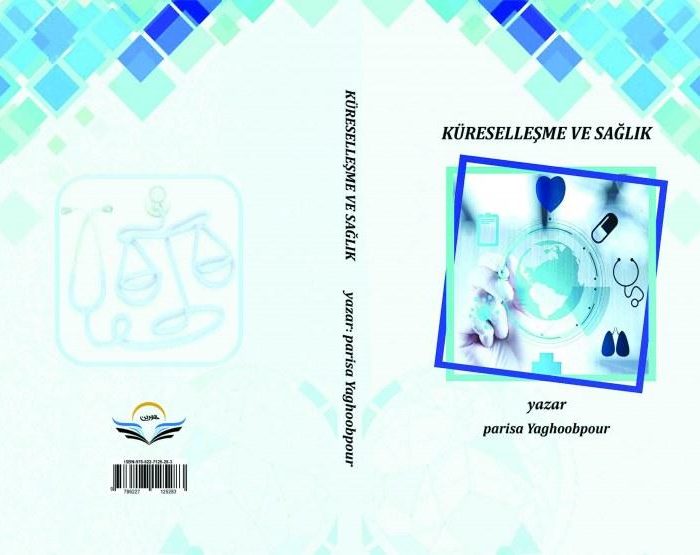کتاب Assessing Interactional Competence through Paired divergent and convergent speaking tasks
- صفحه نخست
- رشته ها
- ادبیات و زبان های خارجی
- کتاب Assessing Interactional Competence through Paired divergent and convergent speaking tasks
کتاب Assessing Interactional Competence through Paired divergent and convergent speaking tasks
۲۶۰,۰۰۰ تومان Original price was: ۲۶۰,۰۰۰ تومان.۱۷۳,۶۸۰ تومانCurrent price is: ۱۷۳,۶۸۰ تومان.
| تعداد صفحات | 130 |
|---|---|
| شابک | 978-622-378-057-8 |
| انتشارات |

کتاب Assessing Interactional Competence through Paired Divergent and Convergent Speaking Tasks
درباره کتاب
کتاب “Assessing Interactional Competence through Paired Divergent and Convergent Speaking Tasks” به تحلیل و ارزیابی توانمندیهای ارتباطی افراد از طریق وظایف کلامی زوجی میپردازد. این کتاب بر روی مقایسهی دو نوع وظیفه کلامی، یعنی وظایف متفاوت (Divergent) و مشابه (Convergent)، تمرکز دارد و بهطور عمیق ویژگیهای این وظایف در ارزیابی توانمندی تعامل کلامی را بررسی میکند.
موضوعات کلیدی کتاب
- معرفی مسئله: کتاب با معرفی مسئلهای در حوزه ارزیابی توانمندی تعامل کلامی آغاز میشود و بهطور مفصل به تحلیل ابعاد مختلف این مسئله در تحقیقات و آزمایشهای مختلف پرداخته است.
- مروری بر ادبیات: در فصل دوم، کتاب به بررسی مباحث مختلفی از جمله توانمندیهای ارتباطی و تعاملات کلامی، به ویژه در آزمونهای گفتاری زوجی و گروهی، پرداخته و مباحث تئوریک و تجربی مختلفی را که در این حوزه مطرح شده است، بررسی میکند.
- مدلهای تئوریک توانمندی تعامل کلامی: این بخش شامل مدلهای مختلف ارزیابی تعامل کلامی مانند مدلهای Hymes (1972)، Canale and Swain (1980)، و Bachman (1990) میباشد و چگونگی توسعه این مدلها در زمینه ارزیابی توانمندیهای کلامی و تعاملات مورد بررسی قرار میگیرد.
- تأثیرات وظایف و همصحبتها: کتاب تأثیرات مختلف وظایف گفتاری و ویژگیهای همصحبتها را در ارزیابی تعامل کلامی مورد تجزیه و تحلیل قرار میدهد. این مباحث شامل تأثیر نوع وظیفه بر عملکرد گفتاری و تأثیر توانمندی زبانی همصحبتها است.
- روششناسی تحقیق: در فصل سوم، کتاب روششناسی تحقیقاتی که برای بررسی توانمندیهای تعامل کلامی طراحی شده است، توضیح داده میشود. این شامل شرح جزئیات مشارکتکنندگان، شیوه جمعآوری دادهها و تحلیلهای آماری مورد استفاده در تحقیق است.
ویژگیهای کلیدی کتاب
- تحلیل مقایسهای وظایف مختلف: این کتاب با تحلیل ویژگیهای مختلف وظایف گفتاری، بهویژه وظایف متفاوت و مشابه، تلاش میکند تا تفاوتهای تأثیرگذار در ارزیابی تعامل کلامی را نشان دهد.
- مبنای تئوریک قوی: کتاب بر اساس مبانی تئوریک معتبر، مدلهای ارزیابی تعامل کلامی و نتایج تحقیقات پیشین، تحلیلهایی عمیق ارائه میدهد.
- تمرکز بر آزمایشهای زوجی: یکی از ویژگیهای منحصر به فرد این کتاب، تأکید بر تحلیل تعاملات کلامی در شرایط زوجی و گروهی است که بهویژه در آزمونهای گفتاری اهمیت زیادی دارد.
- نتایج و پیشنهادات کاربردی: کتاب علاوه بر تحلیلهای تئوریک، نتایج تحقیقاتی را ارائه میدهد که برای محققان و متخصصان حوزه زبانشناسی و آموزش زبان مفید است.
چرا باید این کتاب را بخوانید؟
- برای پژوهشگران و متخصصان آموزش زبان: این کتاب یک منبع ارزشمند برای پژوهشگران و متخصصان است که به دنبال تحلیل و ارزیابی تعاملات کلامی و وظایف مختلف در آزمونهای گفتاری هستند.
- برای دانشجویان زبانشناسی و ارتباطات: دانشجویان این رشته میتوانند با استفاده از مطالب این کتاب، درک عمیقتری از توانمندیهای تعامل کلامی و ارزیابیهای مختلف آن پیدا کنند.
- برای علاقهمندان به تحلیل گفتار و زبانشناسی: این کتاب به هر فردی که علاقهمند به تحلیل تعاملات کلامی و بررسی اثرات مختلف وظایف گفتاری باشد، اطلاعات مفید و کاربردی ارائه میدهد.
مخاطبان هدف
کتاب “Assessing Interactional Competence through Paired Divergent and Convergent Speaking Tasks” برای پژوهشگران، اساتید زبانشناسی، دانشجویان رشتههای زبانشناسی و آموزش زبان، و هر کسی که در زمینه ارزیابی توانمندیهای کلامی و تعاملات گفتاری فعالیت میکند، مناسب است.
درباره خرید کتاب
برای خرید کتاب “Assessing Interactional Competence through Paired Divergent and Convergent Speaking Tasks”، میتوانید به فروشگاههای آنلاین و کتابفروشیهای معتبر مراجعه کنید. این کتاب یک منبع اساسی برای محققان و علاقهمندان به تحلیل تعاملات کلامی و ارزیابی توانمندیهای گفتاری است.
1. کتاب “Assessing Interactional Competence through Paired Divergent and Convergent Speaking Tasks” درباره چه موضوعاتی بحث میکند؟
این کتاب به بررسی مفهوم “لیاقت تعامل” در آزمونهای گفتاری گروهی و جفتی میپردازد. مطالعه در مورد نحوه ارزیابی مهارتهای گفتاری افراد در تعاملات مختلف و تأثیرات انواع مختلف وظایف گفتاری (متفاوت و همسو) بر تعامل و عملکرد آنها است. 📚💬
2. منظور از “Interactional Competence” چیست و چرا در این کتاب به آن پرداخته شده است؟
“Interactional Competence” به توانایی فرد در برقراری ارتباط مؤثر و بهدرستی در تعاملات گفتاری اشاره دارد. کتاب این مفهوم را بررسی کرده و تأثیر آن را بر ارزیابی عملکرد گفتاری در آزمونهای مختلف مورد تحلیل قرار میدهد. 💬🤝
3. کتاب به چه مباحثی در زمینه نظریههای “Communicative Competence” اشاره دارد؟
کتاب به نظریههای مختلفی در زمینه “Communicative Competence” از جمله دیدگاههای Hymes (1972)، Canale and Swain (1980)، Bachman (1990) و Bachman and Palmer (1996) پرداخته است و این نظریهها را بهعنوان مبنای اصلی تحلیل “Interactional Competence” در نظر گرفته است. 📖🌍
4. تفاوت بین “Divergent” و “Convergent Speaking Tasks” در این کتاب چیست؟
“Divergent” به وظایفی اشاره دارد که در آنها شرکتکنندگان باید بهطور آزاد و بدون محدودیت نظر دهند، در حالی که “Convergent” به وظایفی اشاره دارد که در آنها نیاز به توافق یا همراستایی در افکار و نظرات است. این کتاب تأثیرات این دو نوع وظیفه را بر عملکرد تعاملات گفتاری بررسی میکند. 🗣️🔄
5. نتایج اصلی این مطالعه چه بود؟
مطالعه بهطور خاص ویژگیهای مختلف دو نوع وظیفه گفتاری را بررسی کرد. نتایج نشان داد که نوع وظیفه (دوره آزاد یا تکمیل داستان) تأثیر زیادی بر عملکرد تعاملات گفتاری دارد و ویژگیهای خاص هر وظیفه میتواند در ارزیابی “Interactional Competence” مؤثر باشد. 🏆💬
6. کتاب چه تأثیری از نوع “Task” و “Interlocutor” بر آزمونهای گفتاری دارد؟
کتاب به تحلیل تأثیرات مختلف وظایف و گفتوگو کنندگان (Interlocutors) بر ارزیابی تعاملات گفتاری پرداخته است. عوامل مختلفی از جمله توانایی زبانی و نوع وظیفه میتواند بر نتایج این آزمونها تأثیرگذار باشد. 🤔💡
7. چرا “Authenticity” و “Variability” در ارزیابیهای تعاملاتی مهم هستند؟
کتاب به بررسی چالشهای مرتبط با “Authenticity” (اصالت) و “Variability” (تنوع) در ارزیابی تعاملات میپردازد. این دو مفهوم بهطور مستقیم بر دقت و صحت ارزیابیهای مربوط به “Interactional Competence” تأثیر میگذارند و در نظر گرفتن آنها در آزمونها ضروری است. 🧐🌟
8. چه موانعی در ارزیابی “Interactional Competence” وجود دارد؟
یکی از چالشها در ارزیابی “Interactional Competence” این است که ممکن است درک و تأثیر تعاملات به عوامل مختلفی مانند توانایی زبانی، ویژگیهای فرهنگی و نوع وظیفه بستگی داشته باشد. این پیچیدگیها میتوانند نتایج ارزیابیها را تحت تأثیر قرار دهند. ⚖️🤷♀️
9. این کتاب برای چه کسانی مفید است؟
کتاب برای محققان، اساتید، و متخصصانی که در زمینه ارزیابی مهارتهای گفتاری و تعاملات ارتباطی فعالیت دارند مفید است. همچنین برای دانشجویانی که در رشتههای زبانشناسی، آموزش زبان و ارزیابی آزمونها تحصیل میکنند، مفید است. 🎓📘
10. چه پیشنهاداتی برای تحقیقهای آینده از این مطالعه ارائه شده است؟
کتاب پیشنهاداتی برای تحقیقهای آینده در زمینه ارزیابی تعاملات گفتاری ارائه میدهد که شامل بررسی اثرات بیشتر فرهنگ و تفاوتهای زبانی در ارزیابیها و همچنین توسعه مدلهای جدید برای ارزیابی “Interactional Competence” است. 🔍📅
این پرسشها و پاسخها میتواند به خوانندگان درک بهتری از محتوای کتاب و اهمیت مطالعه در زمینه “Interactional Competence” و ارزیابی آن بدهد.
| تعداد صفحات | 130 |
|---|---|
| شابک | 978-622-378-057-8 |
| انتشارات |
.فقط مشتریانی که این محصول را خریداری کرده اند و وارد سیستم شده اند میتوانند برای این محصول دیدگاه ارسال کنند.
محصولات مشابه
-
کتاب BOOK (SPEAKING IN TRAVEL)
۵۷۴,۰۰۰ تومان -
کتاب شناسایی گروتسک در ادبیات معاصر ایران و فرانسه
۳۷۴,۰۰۰ تومانOriginal price was: ۳۷۴,۰۰۰ تومان.۲۶۴,۷۹۲ تومانCurrent price is: ۲۶۴,۷۹۲ تومان. -
کتاب KÜRESELLEŞME VE SAĞLIK
۴۶۸,۰۰۰ تومانOriginal price was: ۴۶۸,۰۰۰ تومان.۳۲۳,۸۵۶ تومانCurrent price is: ۳۲۳,۸۵۶ تومان. -
کتاب I’m you!
۲۸۰,۰۰۰ تومانOriginal price was: ۲۸۰,۰۰۰ تومان.۱۸۹,۲۸۰ تومانCurrent price is: ۱۸۹,۲۸۰ تومان.







دیدگاهها
هیچ دیدگاهی برای این محصول نوشته نشده است.